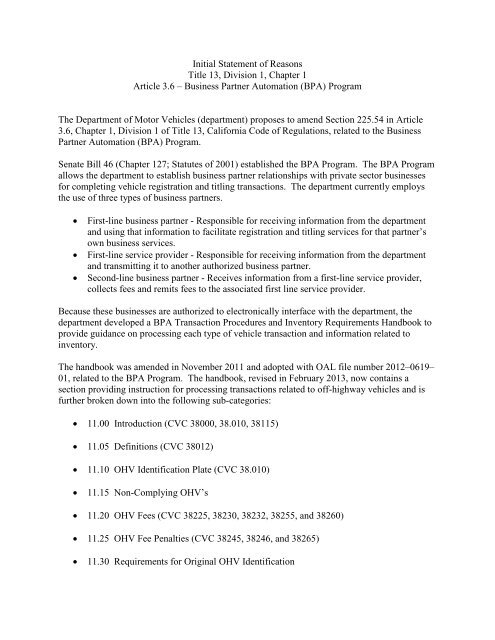Business Partner Automation - California Department of Motor ...
Business Partner Automation - California Department of Motor ...
Business Partner Automation - California Department of Motor ...
Create successful ePaper yourself
Turn your PDF publications into a flip-book with our unique Google optimized e-Paper software.
Initial Statement <strong>of</strong> Reasons<br />
Title 13, Division 1, Chapter 1<br />
Article 3.6 – <strong>Business</strong> <strong>Partner</strong> <strong>Automation</strong> (BPA) Program<br />
The <strong>Department</strong> <strong>of</strong> <strong>Motor</strong> Vehicles (department) proposes to amend Section 225.54 in Article<br />
3.6, Chapter 1, Division 1 <strong>of</strong> Title 13, <strong>California</strong> Code <strong>of</strong> Regulations, related to the <strong>Business</strong><br />
<strong>Partner</strong> <strong>Automation</strong> (BPA) Program.<br />
Senate Bill 46 (Chapter 127; Statutes <strong>of</strong> 2001) established the BPA Program. The BPA Program<br />
allows the department to establish business partner relationships with private sector businesses<br />
for completing vehicle registration and titling transactions. The department currently employs<br />
the use <strong>of</strong> three types <strong>of</strong> business partners.<br />
• First-line business partner - Responsible for receiving information from the department<br />
and using that information to facilitate registration and titling services for that partner’s<br />
own business services.<br />
• First-line service provider - Responsible for receiving information from the department<br />
and transmitting it to another authorized business partner.<br />
• Second-line business partner - Receives information from a first-line service provider,<br />
collects fees and remits fees to the associated first line service provider.<br />
Because these businesses are authorized to electronically interface with the department, the<br />
department developed a BPA Transaction Procedures and Inventory Requirements Handbook to<br />
provide guidance on processing each type <strong>of</strong> vehicle transaction and information related to<br />
inventory.<br />
The handbook was amended in November 2011 and adopted with OAL file number 2012–0619–<br />
01, related to the BPA Program. The handbook, revised in February 2013, now contains a<br />
section providing instruction for processing transactions related to <strong>of</strong>f-highway vehicles and is<br />
further broken down into the following sub-categories:<br />
• 11.00 Introduction (CVC 38000, 38.010, 38115)<br />
• 11.05 Definitions (CVC 38012)<br />
• 11.10 OHV Identification Plate (CVC 38.010)<br />
• 11.15 Non-Complying OHV’s<br />
• 11.20 OHV Fees (CVC 38225, 38230, 38232, 38255, and 38260)<br />
• 11.25 OHV Fee Penalties (CVC 38245, 38246, and 38265)<br />
• 11.30 Requirements for Original OHV Identification
• 11.35 OHV Transfers (CVC 38195)<br />
• 11.40 OHV Renewals (CVC 38115, 38120)<br />
• 11.45 Certificate <strong>of</strong> Planned Non-Operation (PNO) for OHV (CVC 38121)<br />
§ 225.54. Transaction Procedures and Inventory Requirements.<br />
This section is amended to update the revision date <strong>of</strong> the BPA Transaction Procedures and<br />
Inventory Requirements Handbook (handbook) from November 2011 to February 2013.<br />
The handbook was amended to include <strong>of</strong>f highway vehicles to the list <strong>of</strong> transactions that a<br />
business partner is authorized to conduct.<br />
PROBLEMS THIS AGENCY INTENDS TO ADDRESS AND BENEFITS<br />
ANTICIPATED FROM THE REGULATORY ACTION<br />
This regulation only updates the handbook revision date. OHV transactions account for such a<br />
small number <strong>of</strong> the department’s transactions, neither the department nor business partners will<br />
be impacted by this proposed action.<br />
ALTERNATIVES CONSIDERED<br />
No alternatives were considered.<br />
COMPATABILITY WITH FEDERAL REGULATIONS<br />
There are no related federal regulations.<br />
ECONOMIC AND FISCAL IMPACT DETERMINATIONS<br />
• Cost Or Savings To Any State Agency: None.<br />
• Other Non-Discretionary Cost or Savings to Local Agencies: None.<br />
• Costs or Savings in Federal Funding to the State: None.<br />
• Cost Impact on Representative Private Persons or <strong>Business</strong>es: The department is not<br />
aware <strong>of</strong> any cost impacts that a representative private person or business would<br />
necessarily incur in reasonable compliance with the proposed action.<br />
• Effect on Housing Costs: None.<br />
• Local Agency/School District Mandates: The proposed regulatory action will not impose<br />
a mandate on local agencies or school districts, or a mandate that requires reimbursement<br />
pursuant to Part 7 (commencing with Section 17500) <strong>of</strong> Division 4 <strong>of</strong> the Government<br />
Code.
• Small <strong>Business</strong> Impact: The department does not anticipate this proposed action will have<br />
an impact on small business.<br />
DEPARTMENTAL DOCUMENTATION SUPPORTING GOVERNMENT CODE<br />
SECTIONS 11346.2(b)(3) THROUGH (b)(5)<br />
• Studies, Reports or Documents - Gov. Code Sec. 11346.2(b)(3): No technical, theoretical<br />
or empirical studies, reports or documents were relied upon in this proposed action.<br />
• Reasonable Alternatives and <strong>Department</strong>’s Response – Gov. Code Sec. 11346.2(b)(4)(A):<br />
No alternatives were presented that would be as effective.<br />
• Reasonable Alternatives That Would Lessen Any Adverse Impact on Small <strong>Business</strong> –<br />
Gov. Code Sec. 11346.2(b)(4)(B): No alternatives were presented that would lessen any<br />
adverse impact on small business.<br />
• Evidence Supporting Determination <strong>of</strong> No Significant Adverse Economic Impact on<br />
<strong>Business</strong> – Gov. Code Sec. 11346.2(b)(5): This regulation will not have an adverse<br />
economic impact on business. This proposed action provides instructions to business<br />
partners on the procedures to process <strong>of</strong>f-highway vehicle transactions.<br />
RESULTS OF THE ECONOMIC IMPACT ANALYSIS<br />
1) Creation or Elimination <strong>of</strong> Jobs Within the State <strong>of</strong> <strong>California</strong><br />
• This regulatory amendment will neither create nor eliminate jobs within the State <strong>of</strong><br />
<strong>California</strong>.<br />
2) Creation or Elimination <strong>of</strong> Existing <strong>Business</strong> Within the State <strong>of</strong> <strong>California</strong><br />
• This regulatory amendment will neither create nor eliminate existing jobs within the State<br />
<strong>of</strong> <strong>California</strong>.<br />
3) Expansion <strong>of</strong> <strong>Business</strong> Currently Doing <strong>Business</strong> Within the State <strong>of</strong> <strong>California</strong><br />
• This regulatory amendment will not expand those businesses currently doing business in<br />
<strong>California</strong>.<br />
4) Benefits <strong>of</strong> Regulation to the Health and Welfare <strong>of</strong> <strong>California</strong> Residents, Worker Safety and<br />
the State’s Environment<br />
• This regulatory amendment has no benefit to the health and welfare <strong>of</strong> <strong>California</strong><br />
residents, worker safety nor the State’s environment.
















